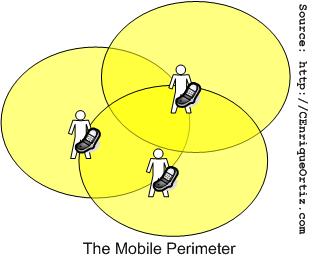
Perimeter: The distance around a figure.
The other day I read via Textually/Ringtonia about a fight that broke out in the Iraqi parliament after a mobile phone ringtone played a Shia Muslim chant – see Shia ringtone sparks scuffle in Iraqi parliament. Later on Ringtonia reported about the controversy caused by another ringtone, “La Migra” (short for Immigration), where Hispanics were offended by the ringtone – see Ringtone Company Sorry for Lyrics Satire.
But, what I find of interest about these two scenarios is the study of usability and something that I've been spending a lot of time formally studying, understanding and defining, and this is the mobile context. The two cases above are concrete examples of one of the elements that comprise the mobile context, and this element is the mobile perimeter, which is the distance between the mobile user and the people around him or her.
The mobile perimeter is a shared space, where intentional and unintentional interactions with others may occur. Of interest is the use of media while in this space. Not all media have the same effect on others sharing this space, and not all media have the same reach or distance, or perimeter effect – if the media doesn't violate other's perimeters, everyone is happy. Talking loud on the phone, ringtones, and other media that crosses boundaries violate other people's spaces. Visual or texting media are not as much of a problem since the mobile perimeter is pretty much contained and thus it doesn't violate other people's spaces. We all know the solution to this problem — courtesy and consideration towards others that are roaming through your mobile space.
But besides the obvious, it also is an interesting and important area of study in usability design of mobile handsets and media.
ceo